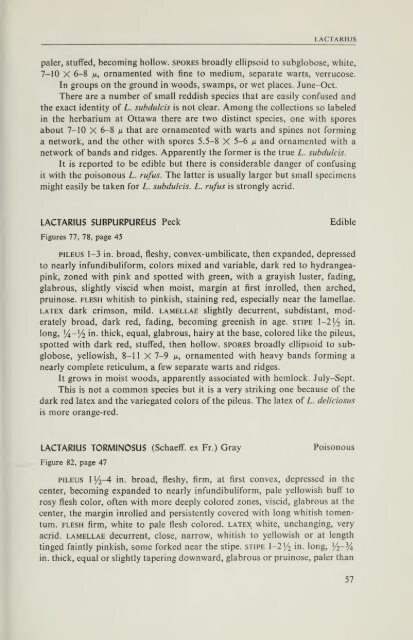You also want an ePaper? Increase the reach of your titles
YUMPU automatically turns print PDFs into web optimized ePapers that Google loves.
LACTARIUS<br />
paler, stuffed, becoming hollow, spores broadly ellipsoid to subglobose, white,<br />
7-10 X 6-8 )u, ornamented with fine to medium, separate warts, verrucose.<br />
In groups on the ground in woods, swamps, or wet places. June-Oct.<br />
There are a number of small reddish species that are easily confused and<br />
the exact identity of L. subdulcis is not clear. Among the collections so labeled<br />
in the herbarium at Ottawa there are two distinct species, one with spores<br />
about 7-10 X 6-8 /u that are ornamented with warts and spines not forming<br />
a network, and the other with spores 5.5-8 X 5-6 /x and ornamented with a<br />
network of bands and ridges. Apparently the former is the true L. subdulcis.<br />
It is reported to be edible but there is considerable danger of confusing<br />
it with the poisonous L. rufus. The latter is usually larger but small specimens<br />
might easily be taken for L. subdulcis. L. rufus is strongly acrid.<br />
LACTARIUS SUBPURPUREUS Peck Edible<br />
Figures 77, 78, page 45<br />
PILEUS 1-3 in. broad, fleshy, convex-umbilicate, then expanded, depressed<br />
to nearly infundibuliform, colors mixed and variable, dark red to hydrangea-<br />
pink, zoned with pink and spotted with green, with a grayish luster, fading,<br />
glabrous, slightly viscid when moist, margin at first inrolled, then arched,<br />
pruinose. flesh whitish to pinkish, staining red, especially near the lamellae.<br />
LATEX dark crimson, mild, lamellae slightly decurrent, subdistant, mod-<br />
erately broad, dark red, fading, becoming greenish in age. stipe 1-2)4 in.<br />
long, 14- V2 in. thick, equal, glabrous, hairy at the base, colored like the pileus,<br />
spotted with dark red, stuffed, then hollow, spores broadly ellipsoid to sub-<br />
globose, yellowish, 8-11 X 7-9 m, ornamented with heavy bands forming a<br />
nearly complete reticulum, a few separate warts and ridges.<br />
It grows in moist woods, apparently associated with hemlock. July-Sept.<br />
This is not a common species but it is a very striking one because of the<br />
dark red latex and the variegated colors of the pileus. The latex of L. deliciosus<br />
is more orange-red.<br />
LACTARIUS TORMINOSUS (Schaeff. ex Fr.) Gray Poisonous<br />
Figure 82, page 47<br />
PILEUS IV2-4 in. broad, fleshy, firm, at first convex, depressed in the<br />
center, becoming expanded to nearly infundibuliform, pale yellowish buff to<br />
rosy flesh color, often with more deeply colored zones, viscid, glabrous at the<br />
center, the margin inrolled and persistently covered with long whitish tomen-<br />
tum. FLESH firm, white to pale flesh colored, latex white, unchanging, very<br />
acrid, lamellae decurrent, close, narrow, whitish to yellowish or at l<strong>eng</strong>th<br />
tinged faintly pinkish, some forked near the stipe, stipe l-lVi in. long, Vi-Va<br />
in. thick, equal or slightly tapering downward, glabrous or pruinose, paler than<br />
57

















